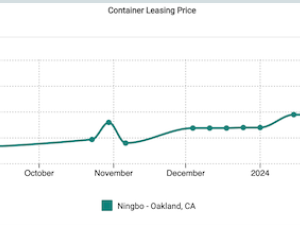The Transpacific Stabilization Agreement (TSA) projects strengthening market conditions in 2007 for ocean carriers in most of the world's major trade lanes. Increasingly strong estimates of cargo demand and moderated estimates of capacity growth will result in a significantly more balanced supply/demand relationship for 2007 than many forecast only a short time ago. That was the consensus that has emerged following a review of market developments by TSA member lines at meetings in Hong Kong.
TSA Members indicated that they see the 2007 outlook for carriers as 'much improved' based on recent market trends, specifically:
- Continued double-digit world trade growth, driven by Asian exports.
- Recent capacity growth estimates point to a more balanced Supply/Demand relationship for the 2007/2008 contract year. This results in part from a broad and consistent recognition by carriers, as is evident from the announcements of both TSA and non-TSA carriers and alliances serving the major East/West trades, that they must adjust their capacity to reduce cost and better align with market demands, not just in the slack season but throughout 2007. This trend has been well publicized in carrier announcements in recent months.
- As has been widely reported, contracting in the Asia Europe trade, which in 2006 led a global downturn in rates, shows a significantly improved environment in 2007, which will positively influence the dynamics in other trade lanes.
- Recognition by carriers and customers alike that the cost pressures impacting landside delivery costs have increased dramatically over the last two years.
- Broad awareness of the poor financial results that most carriers in the industry sustained in 2006, whether members of TSA or not, and the clear need for improved profitability if the industry is going to be able to reinvest to efficiently handle the growth in container trade volumes going forward.
TSA Executive Committee Chairman Ron Widdows said : 'While it is still very early in the year, one can see considerably improved market conditions developing in 2007, based on the dynamics in the Transpacific trade. The trend clearly shows a stronger market than many perceived and our industry appears to be getting a bit smarter about how to manage its business in a challenging environment.'
'Most economic forecasts anticipate growth of 10 to 12% in global trade for 2007. Since most of that trade moves on the ocean, double-digit growth is also expected in demand for container shipping, continuing the robust growth in the Transpacific trade, said Tadamasa Ishida, Executive Vice President of NYK and a member of the new TSA Executive Committee.
Drewry Shipping Consultants of London is predicting a less-than-two percent supply-demand spread for 2007, and with the added challenges of phasing new tonnage into the market and other constraints that impact the amount of 'effective capacity' available at any point in time, 'the concerns of many that there would be an unhealthy excess of capacity in 2007 are, based on developments over the last two months, no longer valid, according to Mr. Ishida.
The focus of carriers and our customers, while beginning to turn to contracting discussions in the Transpacific, will also turn to concerns regarding how to deal with the challenges of landside infrastructure constraints in the US, West Coast organized labor negotiations expected to begin in the first half of 2008, and how best to position their supply chain/cargo flow to manage the continuing risk of a less fluid transportation environment once cargo reaches the terminals, Widdows said.
According to the TSA, cost escalation continues to be a problem for the industry. US railroads have raised intermodal freight rates as much as 30% in 2006 with more increases to come for some. 'We've been struggling with the higher cost of fuel, so it's not feasible to absorb steep increases in






